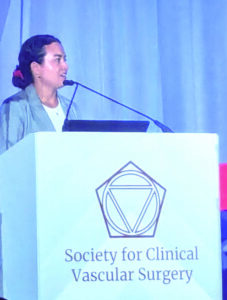
The use of a paclitaxel-eluting stent to treat femoropopliteal occlusive disease led to equivalent outcomes in male and female patients in “a diverse and complex real-world cohort,” a new study found, set against previous question marks over the effectiveness of the technology in women.
A research team from the University of South Florida (USF) in Tampa retrospectively looked at their institutional experience with the Zliver PTX device (Cook Medical), analyzing major adverse limb events (MALEs), amputation-free survival and freedom from target limb revascularization out to five years.
Maria Peñuela, MD, a vascular surgery resident at USF, delivering the data during the 2025 Society for Clinical Vascular Surgery (SCVS) Annual Symposium in Austin, Texas (March 29–April 2), laid out how the Zilver PTX randomized trial data demonstrated clinical durability with improved freedom from target limb revascularization and primary patency at five years compared to bare metal stents. However, she said, the question of whether these data were “reflective of real-world utilization and outcomes” remained, as 91% of the included patients presented with claudication, 34% were female and the mean lesion length was less than 100mm.
The USF single-center retrospective review, therefore, sought to assess the long-term clinical effectiveness of Zilver PTX stents over a seven-year study period from 2013–2019. With a primary outcome measure of MALE at one, two and five years, the review looked at 252 patients with 265 treated limbs that met inclusion criteria. The cohort bore a median age of 65 years and was made up of 37% female patients.
“Overall, the female and male groups were similar with respect to demographics and preop comorbidities; however, male patients more frequently had hyperlipidemia and tobacco use,” Peñuela told SCS 2025.
MALE was defined as reinterventions, stent occlusion or major amputation, she explained, with overall rates similar between both groups and stent occlusion representing the most common event among male and female patients in the cohort, she continued. “Overall mortality was similar between both groups at five years, and amputation-free survival rates were similar across time points for both groups,” Peñuela said. Treatment length did not have any influence on MALE, overall survival or amputation-free survival based on Kaplan-Meier or univariate analysis, she added.
Acknowledging study limitations, Peñuela pointed out the single-center, retrospective nature of the review, further conceding that “we also lacked an institutional endo-comparator, and we had minimal anatomic data, such as calcium burden or GLASS [Global Limb Anatomic Staging System] scores.”












